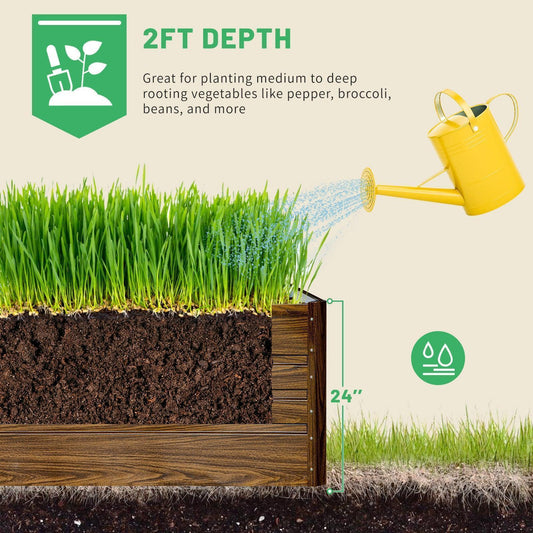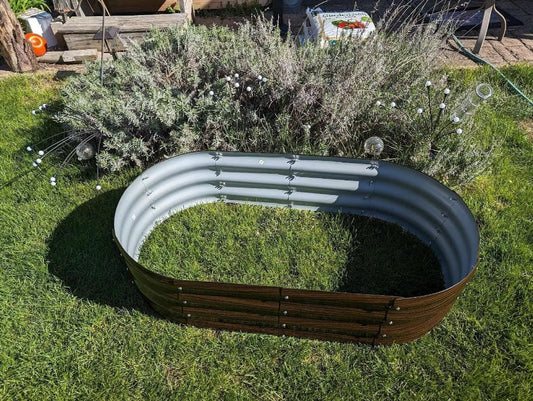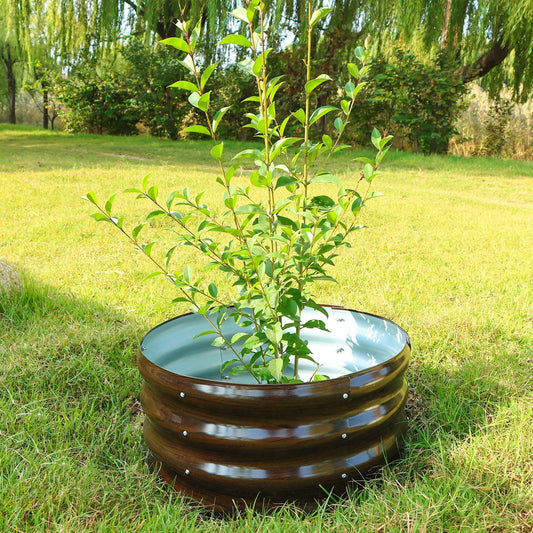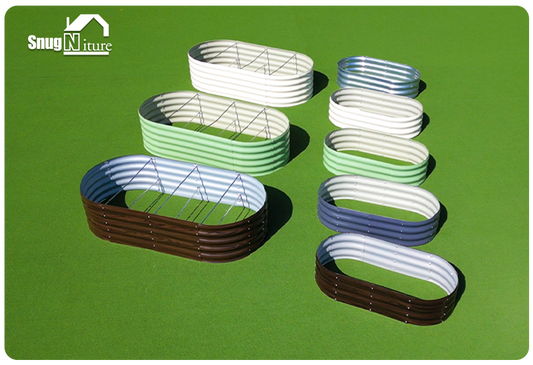Seasonal Gardening Tips for Raised Garden Beds in 2025
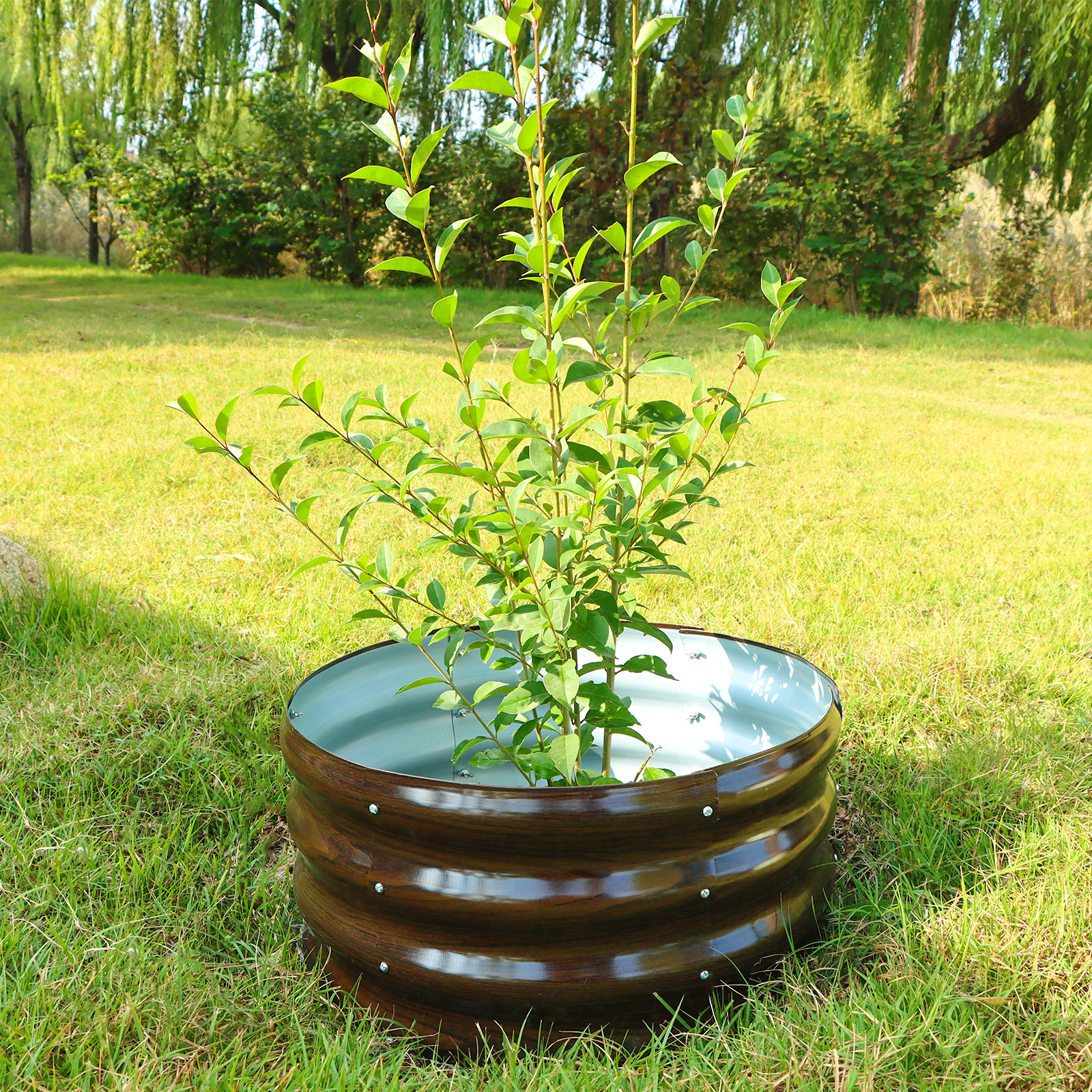
Raised garden beds make seasonal gardening a breeze. Their height saves your back and knees while giving you better control over soil quality and drainage. You can start planting earlier in spring and keep harvesting well into fall. That’s a game-changer, right? Plus, in 2025, gardening trends like creating pollinator-friendly spaces and embracing native plants are taking off. These practices not only help the environment but also make your garden a vibrant, buzzing haven. With a raised garden bed, you’re perfectly set up to grow with the seasons and enjoy every moment.
Key Takeaways
Raised garden beds help your back and knees. They improve soil and drain water better. You can plant earlier in spring and harvest longer in fall.
In spring, grow cool-weather plants like spinach and peas. Add compost to your soil and use mulch to keep it wet.
Summer is great for warm-weather veggies like tomatoes and peppers. Use shade cloths to block too much heat. Drip irrigation keeps the soil moist.
In fall, remove summer plants and grow cool-season veggies like carrots and broccoli. Planting cover crops makes the soil healthier for next year.
Winter gardening works with hardy greens and root veggies. Keep beds warm and add organic matter to prepare for spring.
Spring Seasonal Gardening Tips
Spring is the season of renewal, and your raised garden bed is ready to burst into life. With the right garden plan and planting calendar, you can make the most of this exciting time. Let’s dive into what to plant in spring and how to prepare your growing space for success.
What to Plant in Spring
Early Spring Crops
Early spring is perfect for cool-weather crops that thrive in mild temperatures. Here’s what to plant in spring for a quick and rewarding harvest:
Spinach: Packed with nutrients and ready to harvest in just 4-6 weeks.
Peas: Sweet and crunchy, they grow well in cooler weather.
Radishes: These fast growers are ready in as little as 3-4 weeks.
Kale: Hardy and flavorful, it even tastes better after a light frost.
Lettuce: A mix of leaf varieties adds color and freshness to your salads.
Carrots: Shorter varieties are ideal for raised beds with rocky soil.
Broccoli: Start indoors and transplant early for a head start.
Late Spring Vegetables and Herbs
As the weather warms, you can expand your planting calendar to include heat-loving vegetables and herbs. Tomatoes, peppers, basil, and cilantro are great choices. These crops thrive in the longer days and warmer soil of late spring.
Preparing Your Raised Garden Bed for Spring
Soil Enrichment and Composting
Healthy soil is the foundation of a productive garden. Before planting, enrich your raised garden bed by:
Adding compost or aged manure to boost organic matter.
Mixing in blended topsoil to maintain soil levels.
Applying a fresh layer of compost for a steady nutrient supply.
Pest Prevention and Weed Control
Spring gardening comes with its challenges, but a few seasonal tips can help you stay ahead:
Use intensive planting to cover soil and block weed growth.
Avoid mulch with weed seeds; instead, use compost or living mulch.
Attract beneficial insects like ladybugs to manage pests naturally.
Plant marigolds or garlic as companions to deter unwanted bugs.
Maintenance Tips for Spring
Watering and Drainage Adjustments
Spring weather can be unpredictable. Adjust your watering schedule based on rainfall and ensure your raised garden bed has proper drainage. Drip irrigation systems are a great way to keep the soil evenly moist without overwatering.
Supporting Early Growth with Mulch
Mulch is your best friend for spring gardening. It helps retain moisture, regulates soil temperature, and suppresses weeds. Use organic mulch like straw or shredded leaves to give your plants a strong start.
With these seasonal gardening tips, your raised garden bed will thrive throughout spring. By knowing what to plant and when, you’ll set yourself up for a bountiful harvest in your 2025 garden.
Summer Seasonal Gardening Tips
Summer is the season when your raised garden bed truly shines. With longer days and plenty of sunshine, your garden can thrive if you know what to plant and how to care for it. Let’s explore some tips for summer planting and maintaining your growing space during the hottest months.
What to Plant in Summer
Heat-Tolerant Vegetables
When the summer heat kicks in, certain vegetables thrive in the warm conditions. Here’s what to plant in summer for a productive harvest:
Armenian cucumber
Arugula
Basil
Crowder peas
Eggplant
Ginger
Hot peppers
Kale
Luffa gourd
Malabar spinach
Sweet potatoes
Tomatillos
These crops love the heat and will keep your garden productive all summer long.
Herbs and Flowers for Pollinators
Summer is also the perfect time to plant herbs like lavender, thyme, and oregano. These not only enhance your dishes but also attract pollinators like bees and butterflies. Adding flowers such as zinnias and sunflowers to your garden plan will create a vibrant, buzzing ecosystem.
Caring for Your Raised Garden Bed in Summer
Managing Heat and Sun Exposure
Protecting your plants from excessive heat is crucial. Use shade cloths to shield delicate crops during peak sunlight hours. Position taller plants strategically to provide natural shade for smaller ones. This simple adjustment can make a big difference in your garden’s health.
Irrigation and Mulching Strategies
Keeping your soil consistently moist is key during summer gardening. Automatic drip irrigation systems, like the Garden Grid, are excellent for ensuring efficient watering. You can also try:
Hand watering for better control and plant inspection.
Soaker hoses for direct soil hydration.
Drip lines for durability and water efficiency.
Adding mulch, such as straw or wood chips, helps retain moisture and regulate soil temperature. This is one of the best seasonal tips for summer gardening success.
Maintenance Tips for Summer
Pruning and Harvesting
Regular pruning encourages healthy growth and prevents overcrowding. Harvesting ripe vegetables promptly not only keeps your plants productive but also reduces the risk of pests.
Monitoring for Pests and Diseases
Summer pests can be relentless, but you can stay ahead with these tips:
Use insect netting to keep pests out while allowing sunlight and water in.
Spray neem oil to target harmful insects without damaging your plants.
Introduce natural predators like ladybugs to control pest populations.
By following these tips for summer planting and care, you’ll enjoy a thriving garden all season long. With proper planning and attention, your raised garden bed will remain a productive and beautiful part of your year-round garden care routine.
Autumn Seasonal Gardening Tips
Autumn is a time of transition in your raised garden bed. As summer crops fade, you can prepare your growing space for cool-season vegetables and soil-enhancing cover crops. Let’s explore what to plant in autumn and how to get your garden ready for the colder months.
What to Plant in Autumn
Cool-Season Vegetables
Cool-season vegetables thrive in the crisp autumn air. Some great options include:
Spinach and lettuce for quick, fresh greens.
Carrots and beets, which develop sweeter flavors in cooler weather.
Broccoli and cauliflower, perfect for hearty fall meals.
These crops grow well in shorter days and cooler temperatures, making them ideal for autumn gardening.
Cover Crops for Soil Health
Cover crops are a fantastic addition to your garden plan. They protect and enrich your soil during the off-season. Consider planting winter rye or legumes. These crops:
Compete with weeds, keeping your garden tidy.
Provide a habitat for soil microbes, boosting nutrient cycling.
By adding cover crops, you’re setting the stage for a healthier garden next year.
Preparing Your Raised Garden Bed for Autumn
Clearing Out Summer Plants
Clearing out summer plants is essential for a smooth seasonal transition. Follow these steps:
Harvest remaining crops like tomatoes and peppers before frost hits.
Remove struggling or bolting plants.
Pull weeds and clear debris to tidy up your growing space.
Loosen compacted soil to improve aeration.
This process ensures your raised garden bed is ready for autumn planting.
Adding Organic Matter to Soil
Autumn is the perfect time to enrich your soil. Spread 2-3 inches of organic matter, like compost or aged manure, and mix it into the top six inches of soil. This improves drainage, supports beneficial microbes, and prepares your bed for year-round garden care. Avoid synthetic fertilizers to keep your soil healthy and thriving.
Maintenance Tips for Autumn
Protecting Plants from Early Frost
Early frosts can damage your crops, but you can protect them with these seasonal tips:
Repurpose materials like plastic sheeting or cloches to shield plants.
Position shade cloths to mediate temperature swings.
These simple steps will help your plants survive chilly nights.
Planning for Winterization
Autumn is also the time to think ahead. Rotate your crops to prevent soil depletion and pests. Add mulch to insulate the soil and suppress weeds. By planning now, you’ll make winter gardening easier and set yourself up for success in spring.
With these tips for autumn planting and care, your raised garden bed will stay productive and healthy. Seasonal gardening tips like these ensure your garden thrives no matter the time of year.
Winter Seasonal Gardening Tips
Winter doesn’t mean your gardening journey has to pause. With the right garden plan, your raised garden bed can stay productive even during the coldest months. Let’s explore what to plant in winter and how to care for your garden during this season.
What to Plant in Winter
Hardy Greens and Root Vegetables
Winter is perfect for hardy greens and root vegetables that thrive in cooler temperatures. Here’s what to plant in winter:
Carrots and radishes: These root vegetables grow sweeter in the cold and can handle temperatures above 25°F.
Kohlrabi and turnips: Both are resilient and add variety to your winter harvest.
Kale: This hardy green can overwinter in raised beds, though it may need frost protection in harsher climates.
These crops ensure your garden remains productive and flavorful throughout winter.
Indoor Gardening Options for Raised Beds
If outdoor gardening feels too challenging, try indoor gardening. Raised beds can be adapted for indoor use with grow lights and proper ventilation. Leafy greens like spinach and herbs such as basil thrive indoors. These tips for indoor winter gardening allow you to enjoy fresh produce year-round.
Caring for Your Raised Garden Bed in Winter
Insulating Beds for Cold Weather
Protecting your raised garden bed from freezing temperatures is essential. You can:
Add a 3-inch layer of mulch to insulate the soil and protect plant roots.
Use floating row covers secured with spring clamps to shield plants from frost.
Install cold frames made of wood and polycarbonate for sturdy insulation.
Water the soil before freezing to help insulate perennial roots.
These methods keep your plants cozy and your soil healthy during winter gardening.
Using Row Covers and Cold Frames
Row covers and cold frames are game-changers for winter gardening. They create a microclimate that traps heat, protecting plants from sudden temperature drops. Floating row covers can provide 4-5°F of frost protection, while hoop-supported covers offer up to 10°F. These tools extend your growing season and ensure your crops thrive even in chilly weather.
Maintenance Tips for Winter
Soil Testing and Planning for Spring
Winter is the perfect time to prepare your soil for spring planting. Follow these steps:
Mix 2-3 inches of organic matter, like compost or aged manure, into the topsoil.
Submit a soil sample for pH and nutrient testing.
Adjust nutrient levels based on the results to ensure optimal soil health.
This preparation ensures your raised garden bed is ready for early-spring crops.
Repairing and Reinforcing Raised Beds
Winter is also ideal for inspecting and repairing your raised garden bed. Check for loose screws or damaged panels. Reinforce the structure to withstand harsh weather. A well-maintained bed will last longer and support your gardening efforts year-round.
By following these winter gardening tips, you’ll keep your garden thriving and set yourself up for success in the next growing season.
Why Choose SnugNiture Raised Garden Beds for the 2025 Gardening Season
Benefits of SnugNiture Raised Garden Beds
Durability and Low Maintenance
When it comes to gardening, you want tools that last. The SnugNiture raised garden bed is built from premium galvanized steel, making it resistant to rust and corrosion. This means you won’t have to worry about replacing it anytime soon. Its sturdy design handles all kinds of weather, so whether it’s a rainy spring or a frosty winter, your garden bed stays in top shape. Plus, it’s low maintenance. You can spend more time planting and less time on upkeep.
Eco-Friendly and Sustainable Design
If you care about the environment, this garden bed is a perfect choice. It’s designed with sustainability in mind. The proprietary coating minimizes resource waste, and the materials are 100% recyclable. Even better, for every purchase, SnugNiture partners with One Tree Planted to plant a tree. By choosing this product, you’re not just improving your garden—you’re helping the planet too.
Features That Simplify Seasonal Gardening
Modular and Customizable Design
Every garden is unique, and SnugNiture gets that. Its modular design lets you customize the layout to fit your space, whether it’s a small patio or a sprawling backyard. You can easily assemble and rearrange it to suit your needs. This flexibility makes it a great addition to your 2025 garden setup.
Ergonomic Height for Accessibility
Gardening should be enjoyable, not a strain on your body. The SnugNiture raised garden bed is 12 inches tall, which means less bending and kneeling. This ergonomic height makes it accessible for everyone, including older adults and those with mobility challenges. You’ll love how comfortable it feels to tend to your plants.
How SnugNiture Supports Seasonal Gardening
Easy Assembly and Longevity
No one wants to spend hours setting up a garden bed. With SnugNiture, assembly is quick and straightforward. The clear instructions mean you’ll have it ready in no time. Once it’s set up, its durable construction ensures it will last for years, making it one of the best 2025 supplies for your gardening needs.
Contribution to Environmental Conservation
SnugNiture doesn’t just help you grow plants—it helps grow forests too. By partnering with One Tree Planted, the company contributes to reforestation efforts. Every purchase makes a difference, turning your gardening hobby into a meaningful way to support the environment.
With SnugNiture, you’re not just buying a raised garden bed. You’re investing in a sustainable, durable, and user-friendly solution for the 2025 gardening season.
Seasonal gardening in raised garden beds offers so many benefits. You can plan ahead, rotate crops to keep pests at bay, and even track your progress in a garden journal. Plus, raised beds make it easier to space your plants properly, so they grow without competing for nutrients.
To stay consistent throughout the year, focus on a few key habits:
Add organic compost to enrich your soil.
Start seeds indoors for a head start on the growing season.
Water early in the day to reduce evaporation.
Use mulch to lock in moisture and keep weeds away.
Seasonal gardening isn’t just about growing plants—it’s about enjoying the process. With tools like SnugNiture raised garden beds, you’ll have everything you need to make 2025 your most rewarding gardening year yet. 🌱



